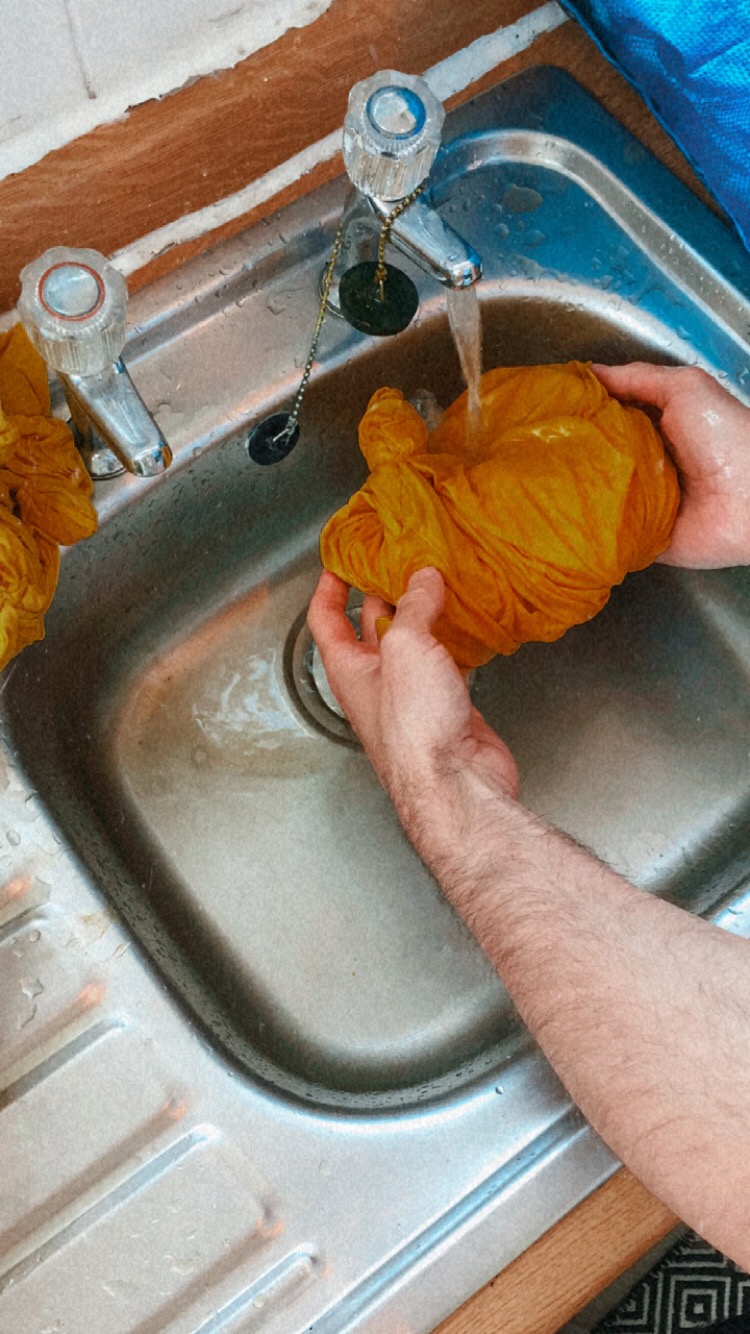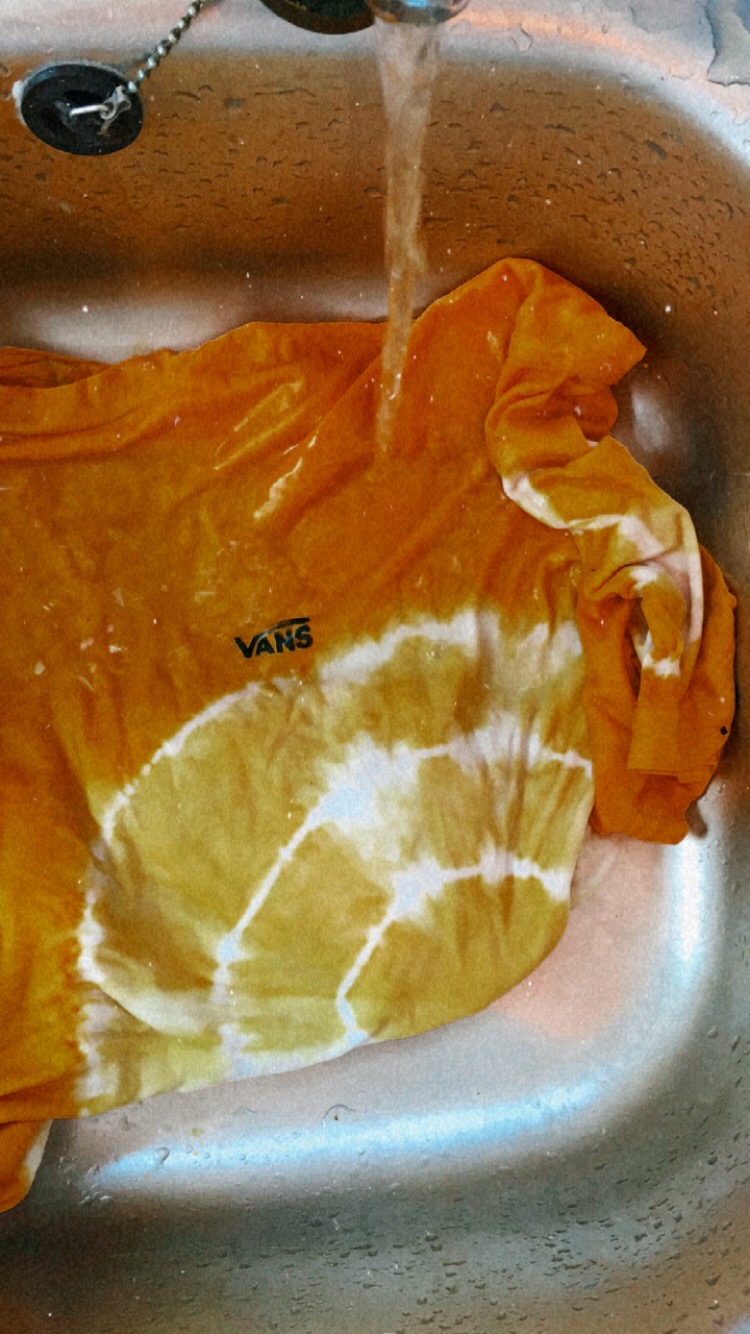Tie-Dye with Turmeric & Save the Planet(?!)
- Kimi- Cinnamon Yoga

- May 18, 2020
- 4 min read
Updated: Oct 12
I have always been a big fan of turmeric, for its magical golden colour, high natural antioxidants, and it's delicious, earthy scent.
I like to add turmeric to my homemade banana bread, and often to my daily juices, but until now I had never considered adding it to my wardrobe.
Given the fact that every time I use turmeric when cooking I end up with sunshine yellow fingertips and staining something or other in my kitchen, I can't believe I never thought of using it to dye fabric. We experimented with a homemade turmeric dye, and were so delighted with the results.
We took a few old, past-their-best items of white clothing and jazzed them up with some golden yellow tie-dye, because, well who doesn't want some sunshine yellow in their life?! It led us on a utopian trip back to a Goan beach, somewhere in the late 1970s....

What you will need for the turmeric tie-dye:
1) Your clothing items. - Use white natural fabrics - cotton, linen, silk.
2) Some white or very light coloured vinegar. - At least one regular sized bottle, around 500ml.
3) Turmeric - I used one standard, supermarket glass spice bottle to dye 3 t-shirts and a pair of socks.
4) String or elastic bands. - If you wish to tie-dye.
Method:
1) To prepare your clothing to allow the colour to set, you firstly need to soak the clothes in vinegar and water.
Add one part vinegar to 4 parts water in a large pan. So one cup of vinegar to every 4 cups of water. Make enough of this mixture to cover (or as close as you can) your clothes inside the pan. Bring to the boil. Turn down and simmer gently for close to 1hr.
2) Prepare your turmeric solution. The more turmeric, the richer the colour! We went for a deep colour as we gathered it will fade over time.
The rough ratio is 3tablespoons of turmeric to 12cups of water. You want to make enough of this mixture to cover the clothing while in a pan/bucket/sink. Heat up on the oven hob, simmer for 15 mins, stirring regularly, then remove from the heat.
3) Drain your clothes from the vinegar solution, rinse well with clean cold water.
4) Now for the creative part! If you want to experiment with tie-dye, grab your string/rubber bands, and get tying. To create the circular patterns as we did, take a few sections and bunch them together to form a sausage shape, and tightly wrap the string around a few sections (as shown in pictures). Cut off any excess string.
5) Submerge the clothing in the turmeric solution.
6) Stir occasionally, leaving in the solution for as long as you can before the excitement makes you take it out for a peek. We left ours in the solution for close to 24hrs... See the bottom of the page for final steps.
Now, make yourself a cup of golden turmeric milk, and sit a while to contemplate the below while you eagerly await the sunny revival of your items:
As we learn more and more collectively about our environmental responsibilities, as of late the spotlight has fallen upon the fashion industry. Move over sleepless nights spent on plastic straws and carrier bags (of course still essential we cut down on our single use plastics), the very clothes on our backs and sheets on our bed have more than a few things to answer for when it comes to environmental kindness..
Fast fashion - the 'wear a few times and then throw away' type attitude to clothing is having a devastating affect on our mother earth.
Rapid, cheap consumption of fashion is no longer something we can allow ourselves to justify.
Here are just a few lasting, damaging effects that fast fashion is causing to our planet right now:
~ It is filling landfills far and wide, taking years & years (upwards of 25 years) to decompose.
~ The water needed to grow cotton for our clothes is immense - 7,000 litres for that favourite pair of jeans!
~ Toxic dyes are leaking into local streams and rivers from the factories where our latest cute summer dress is coming from. Chemicals are coming in to contact with our skin with damaging effects.
It is time to take more responsibility, and to consider where the life of our clothes began, and where it will end.
Consider a few of the following:
~ Clothes swaps / buying second hand
~ Upcycling, customising, natural home dyes- breathe some life back into a pre-loved item.
~ Buying from a company that have strong environmental & ethical morals.
Eg; A friend of mine started the clothing company Monsoon Blooms - all pieces are made using rain-grown cotton, are fully biodegradable and dyed using plants and herbs.
~ Shop less, and buy higher quality, purchase for life.
~ Recycle. Most fabrics can be recycled. Take them to a clothes recycling bank or simply get creative with re-using them.
So, now we feel even happier with ourselves about using natural dye at home to brighten up our wardrobes, we're ready to see the results of our turmeric tie-dye.
Once you are happy with the depth of colour of the fabric:
7) Rinse thoroughly with cold water before taking off any string until the water runs clear.
8) Remove any string, give it a final rinse to remove any residue, and hang to dry!
Tips & notes:
~ Turmeric is a strong, natural colourant, take care with the kitchen items you are using, and consider wearing gloves. Definitely avoid soaking in a ceramic sink!
~ Avoid drying the hand dyed clothes in the sun as this will naturally bleach the colour back out a little.
~ When you next need to, wash in cool water with similar colours after dyeing.
~ Start small and safe. Experiment first with pre-loved clothing, perhaps with existing marks and imperfections. The results can be somewhat unpredictable, and often imperfect, but always fun. I can't wait to try this on some cushion covers for my bed, or a silk sarong.
Other natural dyes I hope to experiment with include beetroot, red cabbage and nettle leaves.


How did you get on? What did you revive? We would love to hear. X
























Comments